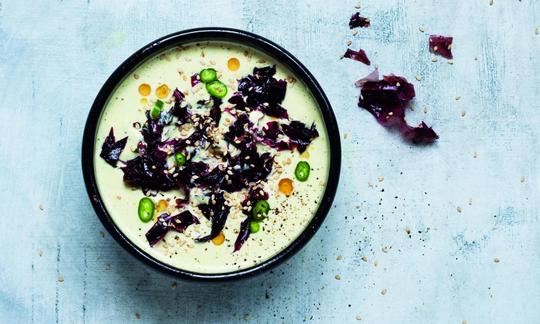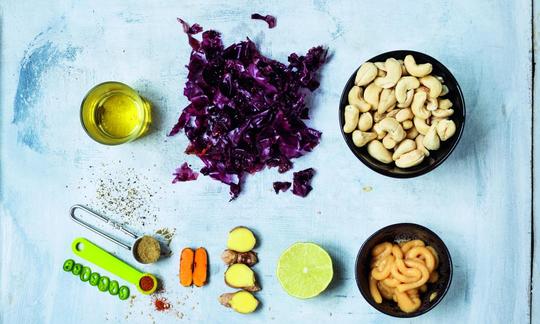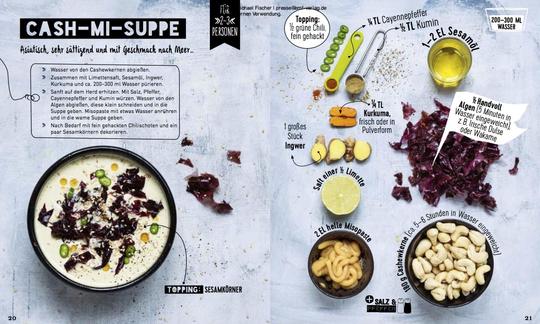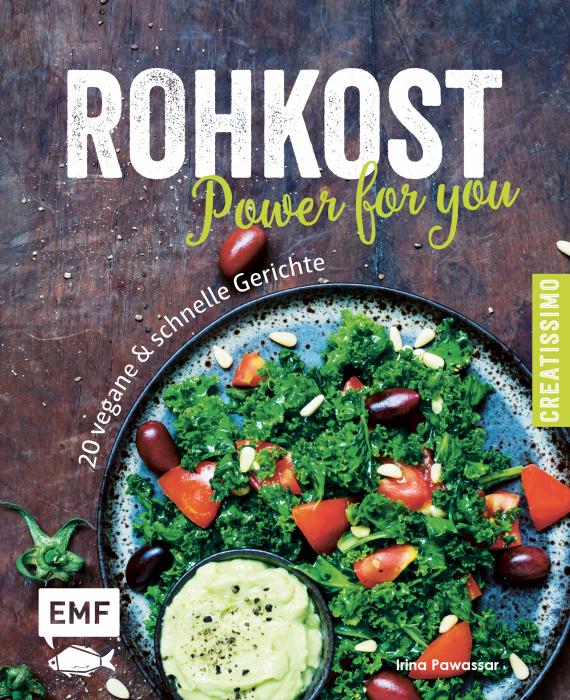Cash-Mi Soup with Cashews, Algae, Ginger, and Turmeric
vegan
Ingredients (for servings, )
| Preparation | |
|---|---|
| 6 ½ oz | Cashew nuts, raw? organic? (cashew nuts) |
| ⅛ oz | Wakame, raw (organic?) |
| For the soup | |
| ½ | Limes, raw (organic?) (1.2 oz) |
| 1 tbsp | Sesame oil, raw? organic? (0.48 oz) |
| 2 tbsp | Ginger, raw (organic?) (0.60 oz) |
| 1 tsp | Turmeric, fresh (raw, organic?) (0.07 oz) |
| 250 ml | Drinking water, raw (organic?) (8.8 oz) |
| Seasoning | |
| 1 dash | Table salt (table salt, raw?, organic?) (0.01 oz) |
| 1 dash | Black pepper (organic?, raw?) (0.00 oz) |
| ¼ tsp | Cayenne pepper (raw?, organic?) (0.02 oz) |
| ½ tsp | Cumin, ground (raw, organic?) (0.05 oz) |
| 1 tbsp | Miso (soybean paste) (0.60 oz) |
| Garnish | |
| ½ | Chili peppers, green (raw, organic?) (0.79 oz) |
| 1 tsp | Sesame, raw, unpeeled (sesame seeds, organic?) (0.11 oz) |
Equipment
- hand-held blender / immersion blender
- stove
- citrus juicer (lemon squeezer)
- saucepan
- sieve
Type of preparation
- chop or grind
- soak
- squeeze
- season to taste
- purée
- drain
Preparation
Preparation
Cover the cashews with plenty of water, soak for 2–6 hours, and then drain. Soak the wakame in water for about 5 minutes and then drain. Finely chop the wakame.For 2–3 servings, the author lists ½ handful of Irish moss or wakame.
Since cashews have a soft consistency, you only need to soak them for about 2 hours.
Preparing the soup incl. seasoning
Juice the lime. Purée the soaked and drained cashews together with the lime juice, sesame oil, ginger, turmeric, and about 200–300 mL water.The original recipe calls for 1–2 tablespoons sesame oil and a large piece of ginger.
It also lists 200–300 mL water for 2-3 servings. Depending on the desired consistency, use slightly less or more than the quantity we recommend.
The original recipe lists ¼ teaspoon fresh or ground turmeric. However, we have deliberately quadrupled the amount of turmeric since good quality ground turmeric in the same quantity is much more flavor intensive.
Gently warm the soup on the stove. Season with salt, pepper, cayenne pepper, and cumin.
Add the prepared wakame to the soup. Combine the miso paste with a little water and then add to the soup.
We have cut the original amount of miso in half. You can add more as needed.
Serving
If desired, garnish the soup with finely chopped chili peppers and some sesame seeds. Serve warm.We have chosen the amount of sesame seeds ourselves; you can use the amount you prefer.
|
Nutritional Information per person
Convert per 100g
|
2000 kcal | |
|---|---|---|
| Energy | 605 kcal | 30.2% |
| Fat/Lipids | 48 g | 68.4% |
| Saturated Fats | 8.2 g | 41.0% |
| Carbohydrates (inc.dietary fiber) | 35 g | 12.9% |
| Sugars | 6.9 g | 7.7% |
| Fiber | 4.6 g | 18.4% |
| Protein/Albumin | 19 g | 37.0% |
| Cooking Salt (Na:435.8 mg) | 1'107 mg | 46.1% |
| Essential micronutrients with the highest proportions | per person | 2000 kcal | |
|---|---|---|---|
| Min | Copper, Cu | 2.2 mg | 215.0% |
| Prot | Tryptophan (Trp, W) | 0.28 g | 114.0% |
| Fat | Linoleic acid; LA; 18:2 omega-6 | 10 g | 104.0% |
| Min | Manganese, Mn | 1.7 mg | 87.0% |
| Elem | Phosphorus, P | 574 mg | 82.0% |
| Elem | Magnesium, Mg | 287 mg | 77.0% |
| Prot | Threonine (Thr, T, irreversibly transaminated) | 0.69 g | 74.0% |
| Min | Iod, I (Jod, J) | 110 µg | 73.0% |
| Prot | Valin (Val, V) | 1.1 g | 66.0% |
| Prot | Isoleucine (Ile, I) | 0.78 g | 63.0% |
Detailed Nutritional Information per Person for this Recipe
The majority of the nutritional information comes from the USDA (US Department of Agriculture). This means that the information for natural products is often incomplete or only given within broader categories, whereas in most cases products made from these have more complete information displayed.
If we take flaxseed, for example, the important essential amino acid ALA (omega-3) is only included in an overarching category whereas for flaxseed oil ALA is listed specifically. In time, we will be able to change this, but it will require a lot of work. An “i” appears behind ingredients that have been adjusted and an explanation appears when you hover over this symbol.
For Erb Muesli, the original calculations resulted in 48 % of the daily requirement of ALA — but with the correction, we see that the muesli actually covers >100 % of the necessary recommendation for the omega-3 fatty acid ALA. Our goal is to eventually be able to compare the nutritional value of our recipes with those that are used in conventional western lifestyles.
| Essential fatty acids | per person | 2000 kcal |
|---|---|---|
| Linoleic acid; LA; 18:2 omega-6 | 10 g | 104.0% |
| Alpha-Linolenic acid; ALA; 18:3 omega-3 | 0.13 g | 6.0% |
| Essential amino acids | per person | 2000 kcal |
|---|---|---|
| Tryptophan (Trp, W) | 0.28 g | 114.0% |
| Threonine (Thr, T, irreversibly transaminated) | 0.69 g | 74.0% |
| Valin (Val, V) | 1.1 g | 66.0% |
| Isoleucine (Ile, I) | 0.78 g | 63.0% |
| Leucine (Leu, L) | 1.4 g | 60.0% |
| Phenylalanine (Phe, F) | 0.93 g | 60.0% |
| Lysine (Lys, K, irreversibly transaminated) | 0.90 g | 49.0% |
| Methionine (Met, M) | 0.35 g | 38.0% |
| Vitamins | per person | 2000 kcal |
|---|---|---|
| Vitamin K | 36 µg | 48.0% |
| Vitamin C (ascorbic acid) | 33 mg | 42.0% |
| Vitamin B1 (Thiamine) | 0.43 mg | 39.0% |
| Vitamin B6 (pyridoxine) | 0.46 mg | 33.0% |
| Vitamin B7 (Biotin, ex vitamin H) | 10 µg | 21.0% |
| Vitamin B9, B11 (Folate, as the active form of folic acid) | 36 µg | 18.0% |
| Vitamin B5 (Pantothenic acid) | 0.89 mg | 15.0% |
| Vitamin E, as a-TEs | 1.2 mg | 10.0% |
| Vitamin B3 (Niacin) | 1.4 mg | 9.0% |
| Vitamin B2 (Riboflavin) | 0.10 mg | 7.0% |
| Vitamin A, as RAE | 13 µg | 2.0% |
| Vitamin B12 (Cobalamin) | 0.01 µg | < 0.1% |
| Essential macroelements (macronutrients) | per person | 2000 kcal |
|---|---|---|
| Phosphorus, P | 574 mg | 82.0% |
| Magnesium, Mg | 287 mg | 77.0% |
| Sodium, Na | 436 mg | 54.0% |
| Potassium, K | 729 mg | 36.0% |
| Calcium, Ca | 77 mg | 10.0% |
| Essential trace elements (micronutrients) | per person | 2000 kcal |
|---|---|---|
| Copper, Cu | 2.2 mg | 215.0% |
| Manganese, Mn | 1.7 mg | 87.0% |
| Iod, I (Jod, J) | 110 µg | 73.0% |
| Zinc, Zn | 5.7 mg | 57.0% |
| Iron, Fe | 7.3 mg | 52.0% |
| Selenium, Se | 19 µg | 35.0% |
| Fluorine, F | 93 µg | 3.0% |
Edition Michael Fischer GmbH, Irina Pawassar
Raw recipes 17 (2), Cooked recipes 3 (1)
Additional photos (9)
Raw Food Power For You – 20 vegan & quick dishes contains a small, varied selection of quick, everyday, raw vegan recipes.
Since this book is written in German, a description is omitted here. If you are interested, please switch to German in the menu.
This Asian Cash-Mi Soup with Cashews, Miso, Algae, Ginger, and Turmeric is very filling and tastes like the sea. Note the iodine content of the algae.
Nutritional profile: According to GDA guidelines, one serving of this recipe covers the recommended daily requirement for copper and tryptophan. In addition, it contains more than ¾ of the recommended daily requirement for manganese, phosphorus, and magnesium. However, the ratio of omega-6 to omega-3 fatty acids is not well balanced as it significantly exceeds the recommended 5:1 ratio.
Turmeric: Curcumin, one of the orange-yellow pigments in turmeric, has many beneficial effects on our health. These include, for example, anticarcinogenic and anti-inflammatory properties as well as antioxidant effects. There are also indications that turmeric has a positive effect on our bones and psychological well-being (as an antidepressant).
We have classified the recipe as a cooked recipe because it includes the ingredients wakame, miso, and cashews. Find out more about these ingredients here:
Wakame: Wakame is a brown algae that is mainly used in Asia to season stews and soups. But sea vegetables are also regaining importance in Europe. Wakame has a crunchy consistency and has a taste reminiscent of the sea. It can be used raw or cooked. Wakame is generally sold dried in Europe and whether or not it is raw depends on the type of drying and processing methods used! It is normally pasteurized (e.g., at 85 °C) for 25 minutes.
Miso: Miso is a Japanese paste made mainly from soybeans with varying proportions of rice, barley, and other grains. It is a natural flavor enhancer that tastes like fermented beans and can be pungent to sweet. Strictly speaking, miso is not a raw food. During the production process, the soybeans are heated because green beans of all kinds contain the glycoprotein phasin, which is toxic to humans. Phasin impairs the absorption of nutrients in the intestine, causes red blood cells to clump (hemagglutinating effect), and in higher doses can also destroy the intestinal villi. Heating processes (e.g., cooking and roasting) destroy phasin and therefore make soybeans and soybean products such as tofu, miso, and tempeh edible for humans. This means that even unpasteurized soy products are not raw, but merely cooked foods that have been “revived” through fermentation.
Cashews: There is hardly another food that contains a higher proportion of the essential amino acid tryptophan than cashews. Tryptophan is an essential nutrient in the production of the neurotransmitter serotonin. Cashews are also a good source of minerals such as magnesium and iron. However, cashews cannot be eaten raw because they contain the toxic oil cardol. When sold commercially, they have either been steamed or roasted and are therefore not truly raw. This means that they’re not raw in the strict sense of the word. If “Raw cashews” is on the label, this usually just means that the toxic cardol they contain has been deactivated by steaming instead of roasting. It is only when the process is explained in detail and controlled that we can be sure the cashews are raw.
Iodine and algae: With algae, you should look and see how much iodine it contains. Iodine is an essential trace element that occurs primarily in the form of iodide and is especially important for the production of certain thyroid hormones. A deficiency can cause hypothyroidism, but if you consume too much it can overburden your thyroid and be harmful to your health. The type of iodine found in algae depends on the type of algae, time of harvest, location, and processing. For example, 100 g of dried wakame may contain such a high amount of iodine that it is enough to meet the requirement for a month. An average iodine intake of more than 1,000 µg per day can lead to various clinical issues.
Turmeric stains: If you are using fresh turmeric root, you should wear gloves as turmeric can stain your hands It can also stain light-colored kitchen appliances.
Ginger for indigestion: Ginger not only warms us from the inside; thanks to the substances it contains, it also promotes blood flow. The properties of ginger that stimulate the circulatory system help relieve digestive problems, nausea, and dizziness. The active ingredient gingerol gives ginger its characteristic strong, spicy taste and is responsible for its beneficial effects. As a pungent substance, acid amide stimulates the secretion of gastric juice and the peristalsis of the gastrointestinal tract in a reflex manner, which is why it is also used in phytotherapy (use of plant-derived medications in the treatment and prevention of disease) for functional stomach problems.
Substitute for sesame seeds: If you are allergic to sesame seeds, you can replace the sesame seeds with other seeds or nuts and use another type of vegetable oil.
Algae: Instead of wakame, you can also use Irish moss or another type of algae.
Turmeric: If you don’t have any fresh turmeric on hand, you can instead use ground turmeric.
High salt content: The high salt content mainly comes from the ingredient miso. Excessive salt consumption is anything but beneficial to your health, and it is worth it to reduce the amount of salt you consume: a total of 2.5 g of table salt (1 g of sodium) per day is optimal, especially if you have high blood pressure. This is why we have cut the amount of miso paste called for in the original recipe in half.








